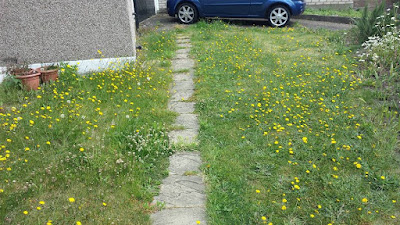 |
| A House Sparrow on the roof of my garage in Penge, South East London |
But since 1967 their numbers have declined by 67%. Ornithologists from the BTO have suggested a couple of reasons for this. Firstly lots of gardens in towns have been either decked, paved, graveled or had a whopping great big trampoline put in them, lawns are obsessively mown and weeds removed with impunity. This removes both habitat for nesting and also a source of seeds and insects. Secondly modern homes don't have the little nooks and crannies that older homes have in abundance, again another important source of nesting habitat for the House Sparrow. The combination of both of these factors is what has silenced that happy little 'churp' from our streets. I am fortunate; I live in the Alexandra Cottages in Penge. These are a series of terraced social housing streets constructed as a bit of a social experiment in the early 19th Century, There are tons of little hidy holes for the sparrows to flit about in, trees and a mature hedge. Consequently there is a relatively large population here.
However conservation of species, particularly in urban settings, is about doing your little bit to help. If we all did so then many of our species (the Hedgehog anyone?) would be in much better shape than they currently are. With that in mind this Spring and Summer I have engaged in a little rewilding project of my own! Braving the passive aggressive distaste of the Alexandra residents association I have left my lawn unmown and my borders relatively weedy. Immediately I noticed more bees, bugs and ants in the garden. I have had a feeder up for the birds for a while but I now also see them feeding in my 'meadow'. A Lapwing will land soon, just you see.
 |
| My wildflower meadow, just one of the mosaic of habitats present in the Penge Nature Reserve |
There is a little ecosystem in my yard and front garden which is really thriving. The House Sparrows feed from my feeder and lawn, Wood Pigeons and Collared Doves mop up after them and Blue Tits and Goldfinches, although not brash enough to visit my feeder which is very close to the back door, flit among the trees and border picking off insects. I have Blackbirds on my roof and in my garden and even a little mouse (that Inna and I have dubbed Charlie) picks up the husks and bits the birds don't want. One of the most spectacular sights are the Swifts, feeding hundreds of feet above the houses in long graceful flights. These are the Spitfires of the bird world and are another species that is struggling due to the modernisation of our homes. Although I have no way of knowing it I like to think that some of the insects they are feeding on up there were hatched in my weedy border and long grass!
Penge national nature reserve, free to visit but please leave a donation.
I think we should re-introduce bears to Penge; they would have plenty of fast-food leftovers to forage and they could be trained to shit in Crystal Palace Park woods.
ReplyDeleteThey might reduce crime a bit as well
ReplyDelete